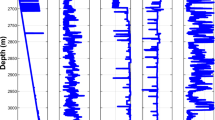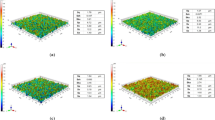Abstract
A predictive model is presented to optimize deep drilling operations under high speed conditions for the manufacture of steel components such as moulds and dies. The input data include cutting parameters and axial cutting forces measured by sensors on the milling centres where the tests are performed. The novelty of the paper lies in the use of Bayesian Networks that consider the cooling system as an input variable for the optimization of roughness quality in deep drilling operations. Two different coolant strategies are tested: traditional working fluid and MQL (Minimum Quantity Lubrication). The model is based on a machine learning classification method known as Bayesian networks. Various measures used to assess the model demonstrate its suitability to control this type of industrial task. Its ease of interpretation is a further advantage in comparison with other artificial intelligence tools, which makes it a user-friendly application for machine operators.
Similar content being viewed by others
References
1302 I. (1992). Technical drawings—method of indicating surface texture. International organization for standardization.
4288 I. (1996). Geometrical product specifications (GPS)—surface texture: Profile method—rules and procedures for the assessment of surface texture. International organization for standardization.
Abukhshim N., Mativenga P., Sheikh A. (2006) Heat generation and temperature prediction in metal cutting: A review and implications for high speed machining. International Journal of Machine Tools and Manufacture 46(7–8): 782–800
Baradie M. E. (1996) Cutting fluids: Part i. Characterisation. Journal of Materials Processing Technology 56: 786–797
Biermann D., Kersting M., Kessler N. (2009) Process adapted structure optimization of deep hole drilling tools. CIRP Annals Manufacturing Technology 58(1): 89–92
Biglari F., Fang X. (1995) Real-time fuzzy-logic control for maximizing the tool life of small-diameter drills. Fuzzy Sets and Systems 72(1): 91–101
Braga D., Diniz A., Miranda G., Coppinni N. (2002) Using a minimum quantity of lubrication and a diamond coated tool in drilling of aluminum-silicon alloys. Journal of Materials Processing Technology 122: 127–138
Castillo E., Gutiérrez E., Hadi A. (1997) Expert systems and probabilistic network models. Springer, NY
Chandrasekaran M., Muralidhar M., Krishna C. M., Dixit U. S. (2010) Application of soft computing techniques in machining performance prediction and optimization: A literature review. International Journal of Advanced Manufacturing Technologie 46: 445–464
Chawla N., Bowyer K., Hall L., Kegelmeyer W. (2002) Smote: Synthetic minority over-sampling technique. Journal of Artificial Intelligence Research 16: 321–357
Choudhary A., Harding J., Tiwari M. (2009) Data mining in manufacturing: A review based on the kind of knowledge. Journal of Intelligent Manufacturing 20(5): 501–521
Chow C., Liu C. (1968) Approximating discrete probability distributions. IEEE Transactions on Information Theory 14: 462–467
Coldwell H., Woods R., Paul M., Koshy P., Dewes R., Aspinwall D. (2003) Rapid machining of hardened aisi h13 and d2 moulds, dies and press tools. Journal of Materials Processing Technology 135: 301–311
Correa M., Bielza C., de Ramirez J. M., Alique J. (2008) A bayesian network model for surface roughness prediction in the machining process. International Journal of Systems Science 39(12): 1181–1192
Correa M., Bielza C., Pamies-Teixeira J. (2009) Comparison of bayesian networks and artificial neural networks for quality detection in a machining process. Expert Systems with Applications 36: 7270–7279
Davim J., Sreejith P., Gomes R., Peixoto C. (2006) Experimental studies on drilling of aluminium (aa1050) under dry, minimum quantity of lubricant, and flood-lubricated conditions. Proceedings of the Institution of Mechanical Engineers Part B-Journal of Engineering Manufacture 220(10): 1605–1611
Filipovic A., Stephenson D. (1996) Minimum quantity lubrication (mql) applications in automotive power-train machining. Mechanical Science and Technology 10: 3–22
Friedman N., Geiger D., Goldszmit M. (1997) Bayesian network classifiers. Machine Learning 29: 131–161
Grzenda, M., Bustillo, A., Zawistowski, P. (2010). A soft computing system using intelligent imputation strategies for roughness prediction in deep drilling. Journal of Intelligent Manufacturing, 1–11. Article in Press.
Haber R., Haber-Haber R., Jimenez A., Galan R. (2009) An optimal fuzzy control system in a network environment based on simulated annealing. An application to a drilling process. Applied Soft Computing Journal 9(3): 889–895
Hashmi K., Graham I., Mills B. (2000) Fuzzy logic based data selection for the drilling process. Journal of Materials Processing Technology 108(1): 55–61
Hayajneh N. (2001) Hole quality in deep hole drilling source. Materials and Manufacturing Processes 16(2): 147–164
Heinemann R., Hinduja S., Barrow G., Petuelli G. (2006) Effect of mql on the tool life of small twist drills in deep-hole drilling. International Journal of Machine Tools and Manufacture 46(1): 1–6
Heinemann R., Hinduja S., Barrow G. (2007) Use of process signals for tool wear progression sensing in drilling small deep holes. International Journal of Advanced Manufacturing Technology 33(3–4): 243–250
Jantunen E., Vaajoensuu E. (2010) Self adaptive diagnosis of tool wear with a microcontroller. Journal of Intelligent Manufacturing 21(2): 223–230
Karnik S. R., Gaitonde V. N., Davim J. P. (2008) A comparative study of the ann and rsm modeling approaches for predicting burr size in drilling. International Journal of Advanced Manufacturing Technology 38(9–10): 868–883
Kubota H., Tabei H. (1999) Drilling of a small and deep hole using a twist drill. Transactions of the Japan Society of Mechanical Engineers, Part C 62(601): 3691–3697
Lorincz J. (2006) Drilling to the limits: Innovative holemaking tools can improve cycle time, reduce cost per hole. Manufacturing Engineering 136(4): 71–75
Mehrabadi I., Nouri M., Madoliat R. (2009) Investigating chatter vibration in deep drilling, including process damping and the gyroscopic effect. International Journal of Machine Tools & Manufacture 49(12–13): 939–946
Nandi A., Davim J. (2009) A study of drilling performances with minimum quantity of lubricant using fuzzy logic rules. Mechatronics 19(2): 218–232
Neapolitan R. (2004) Learning bayesian networks. Prentice Hall, Englewood Cliffs
Ripley B. (1996) Pattern recognition and neural networks. Cambridge University Press, Cambridge
Sanjay C., Neema M., Chin C. (2005) Modeling of tool wear in drilling by statistical analysis and artificial neural network. Journal of Materials Processing Technology 170(3): 494–500
Weinert K., Inasaki I., Sutherland J., Wakabayashi T. (2004) Dry machining and minimum quantity lubrication. Annals CIRP 53(2): 511–537
Zang J., Liang S., Yao J., Chen J., Hang J. (2006) Evolutionary optimization of machining processes. Journal of Intelligent Manufacturing 17(2): 203–215
Zhang J., Chen J. (2009) Surface roughness optimization in a drilling operation using the taguchi design method. Materials and Manufacturing Processes 24(4): 459–467
Author information
Authors and Affiliations
Corresponding author
Rights and permissions
About this article
Cite this article
Bustillo, A., Correa, M. Using artificial intelligence to predict surface roughness in deep drilling of steel components. J Intell Manuf 23, 1893–1902 (2012). https://doi.org/10.1007/s10845-011-0506-8
Received:
Accepted:
Published:
Issue Date:
DOI: https://doi.org/10.1007/s10845-011-0506-8




